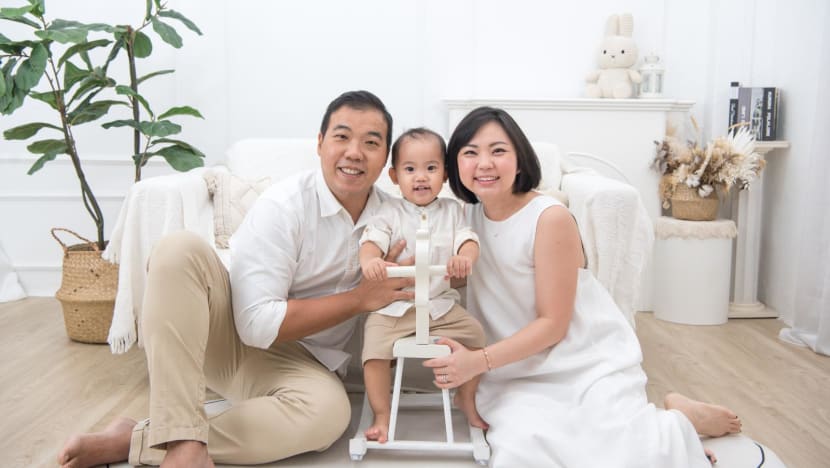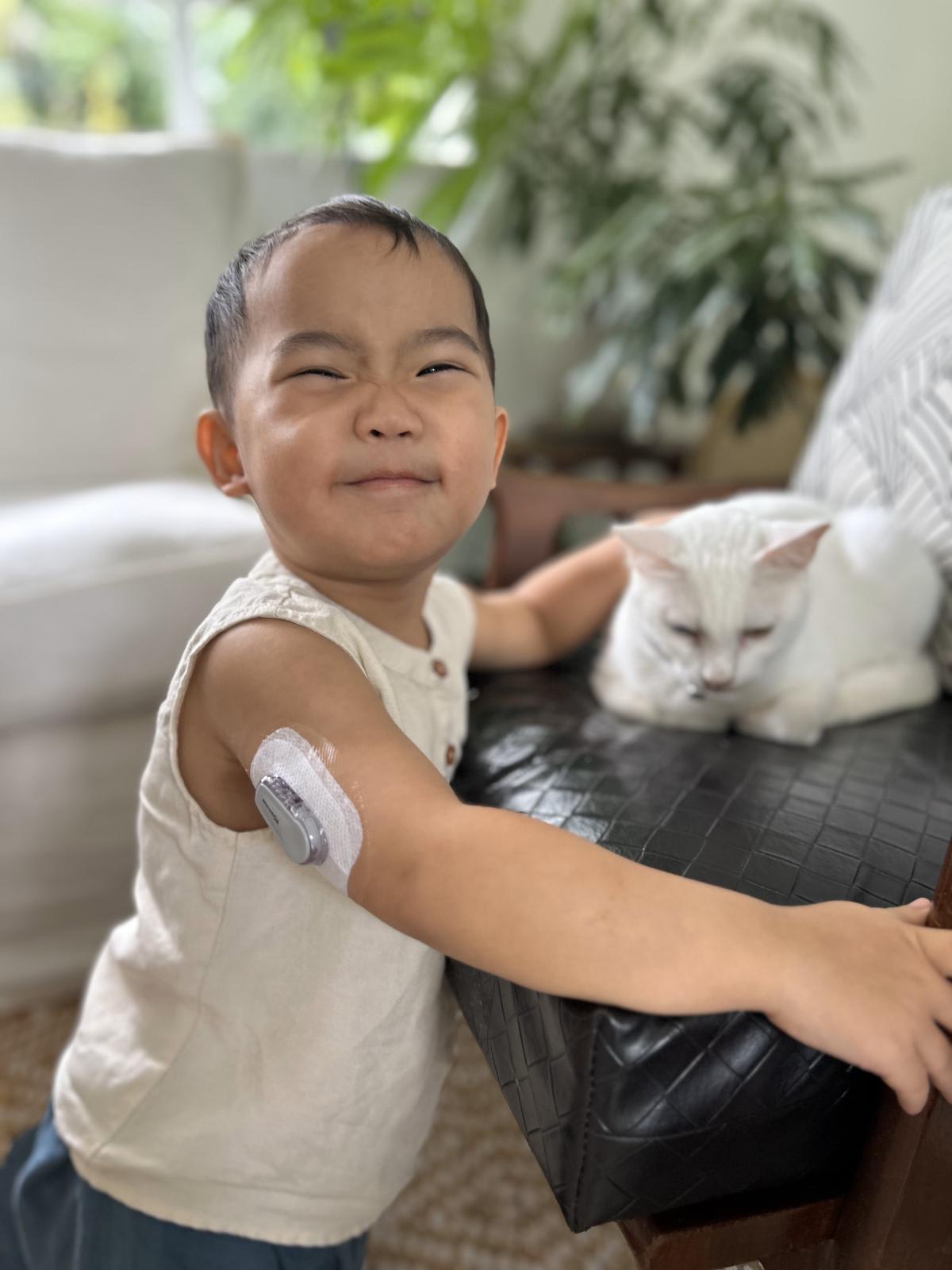Type 1 diabetes patients welcome subsidies for glucose monitoring system, but call for more support
The Ministry of Health now subsidises up to 80 per cent of the cost of a continuous glucose monitoring system and its components, which will benefit over 2,000 adults and children with Type 1 diabetes.

Three-year-old Mason Lee was diagnosed with Type 1 diabetes at the age of one. (Photo: Amazing Baby Singapore)

This audio is generated by an AI tool.
SINGAPORE: At three years old, Mason Lee is everything you would imagine a toddler to be – energetic and fun-loving.
As he runs around in the playground, the only noticeable difference between him and other children is a white patch on the back of his arm.
The patch is a sensor that automatically measures his blood glucose every few minutes and transmits the information to his mother’s phone, allowing her to track changes in the level.
It is a necessity for Mason, who was diagnosed with Type 1 diabetes two years ago. An autoimmune disease, Type 1 diabetes is a chronic condition that prevents the body from producing insulin normally.
If his blood sugar level is too low, this could lead to seizures, coma or even death. If it gets too high, it can damage nerves and blood vessels over time, causing serious health complications including heart disease and stroke.
Before he was put on the continuous glucose monitoring (CGM) system, the three-year-old had to endure four to six finger prick tests a day.
While the CGM system reduces the need for such tests, it is costlier. According to checks online by CNA, a sensor, which can only be used for up to 10 days, costs anywhere between S$80 and S$100 (US$60 and US$76).

MANAGING COSTS
Following a review of clinical evidence and the cost-effectiveness of CGM systems for Type 1 diabetes, the Ministry of Health (MOH) now subsidises up to 80 per cent of the cost.
Currently, only one model of CGM systems – Dexcom G6 CGM – is subsidised.
A ministry spokesperson told CNA that it started subsidising this in May for eligible adults and children with Type 1 diabetes receiving care at public healthcare institutions.
Over 2,000 children and adults will benefit from the subsidies, said MOH.
In its review, the ministry found that the CGM systems benefited children and adults who could not achieve optimal control of their blood glucose level, despite insulin therapy and conventional monitoring methods such as finger prick tests. It would also help those who experience disabling or problematic hypoglycaemia (low blood sugar) or unacceptably high blood sugar levels.
Due to the nature of the disease and the demands of its management, endocrinologist Dr Kevin Tan said CGM is particularly valuable for individuals with Type 1 diabetes.
As those with Type 1 diabetes produce little to no insulin, this requires them to carefully manage insulin levels throughout the day.
“CGM provides real-time glucose data, which is crucial for making immediate adjustments to insulin doses. This continuous monitoring helps prevent dangerous highs and lows in blood sugar, which can be life-threatening,” said Dr Tan, adding that it also allows for better control and more precise insulin management.
In addition, with Type 1 diabetics at higher risk of hypoglycemia (low blood sugar), especially during sleep or physical activity, he said the CGM can alert users to dropping glucose levels before they become dangerously low, providing an opportunity to take corrective action.
“In individuals living with Type 2 diabetes, even though the above are all important, it is not as critical. Moreover, the majority of Type 2 diabetes individuals are on oral anti-diabetic agents or sometimes not on medication at all,” said Dr Tan.
Unlike Type 2 diabetes, which is associated with being overweight and usually can be improved with diet and exercise, Type 1 diabetes is not caused by diet or lack of exercise and can occur at any age.
The subsidies were welcomed by Mason’s parents as they only have to pay S$42 for the sensor – about half the original cost.
“The subsidies are a good start, it’s better than nothing … but (his total diabetes-related expenses) is still no small sum,” said his mother Carmen Lee, adding that the family spends about S$1,000 every quarter on Mason’s diabetes-related expenses.
“There are some things that we can't quantify like skin care products (to deal with Mason’s allergy to the adhesive on the sensors) the time and energy as well. It's a very expensive kind of disease to manage.”
Despite the cost, Ms Lee, who works full-time as a veterinarian, said the CGM system offers her peace of mind and allows her son to lead a more normal life.
“It gives Mason a lot more freedom to just be a kid … we can be less restrictive with his childhood, in terms of his diet … his activity, because we can see what's happening in real time,” said Ms Lee.
“Our priority as parents is always normality for our child. We want him to live life as normal as possible, we don't want him to go through any kind of stigma that is diagnosed with this disease or be so different from his friends.
“It's really important to us as parents that he knows that he can do everything and anything everyone else does and the CGM really helps with that.”
CALLS FOR MORE AWARENESS
According to Type 1 diabetes global registry T1 Index, 6,187 people in Singapore have this form of the disease.
With Type 1 diabetes being less common than Type 2, Dr Tan said patients often face additional challenges as the lower prevalence means that public awareness and understanding of the condition are generally limited.
This can result in misconceptions, social stigma and a lack of empathy from others who may not fully appreciate the daily management difficulties that individuals living with Type 1 diabetes experience, he said.
“Additionally, health education programmes tend to focus more on Type 2 diabetes, leading to a lack of targeted education and awareness for Type 1 diabetes,” he added.
“This could result in fewer opportunities for early diagnosis, proper management, and understanding of the unique needs of individuals living with Type 1 diabetes.”
In speaking out about her son's condition, Ms Lee said she hoped to create more awareness and garner more support for those living with the disease.
"We do have quite a small but close-knit community here in Singapore in terms of the parents (of children with Type 1 diabetes), even with the adult type ones too," she said.
"We parents are always talking about how the children and their parents are managing in school ... because by the time (the child) reaches primary school ... the teachers are not allowed to administer any medication whatsoever, including insulin, to the students," she said.
"So it's either the young children have to learn how to (inject) themselves with a needle many times a day ... or their parents have to sacrifice their careers to go to school and administer the injections.
“As parents, we take care of our children but in the future, this is their burden to bear. So obviously, we hope to make it as easy for them as possible for the future.”
Editor's note: An earlier version of this article stated that the Lee family spends S$5,000 every quarter on Mason's medical expenses. This should be S$1,000. We apologise for the error.
















